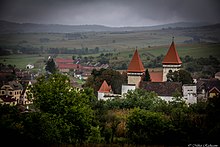Schönberg (Sibiu District)
|
Dealu Frumos Schönberg Lesses |
||||
|
||||
| Basic data | ||||
|---|---|---|---|---|
| State : |
|
|||
| Historical region : | Transylvania | |||
| Circle : | Sibiu | |||
| Municipality : | Merghindeal | |||
| Coordinates : | 45 ° 59 ' N , 24 ° 42' E | |||
| Time zone : | EET ( UTC +2) | |||
| Height : | 475 m | |||
| Residents : | 547 (2002) | |||
| Postal code : | 557141 | |||
| Telephone code : | (+40) 02 69 | |||
| License plate : | SB | |||
| Structure and administration | ||||
| Community type : | Village | |||
Schönberg ( Romanian Dealu Frumos , more rarely Dealul Frumos , formerly Șulumberg , Hungarian Lesses ) is a village in Transylvania ( Romania ). Administratively it belongs to the municipality of Merghindeal (Mergeln) .
Geographical location

The village of Schönberg is located in the historic Altland , on the district road (drum județean) DJ 105, almost sixty kilometers northeast of the district capital Sibiu (Hermannstadt) , near Agnita (Agnetheln) , in the northeast of the Sibiu district . The geographical center of Romania is located near the entrance to the town from the direction of Agnita (within the borders since 1945).
history
founding
Schönberg was founded by the Transylvanian Saxons in the middle of the 12th century . Around 1300 the place was first mentioned as Pulchromonte .
Recent history
At the end of the 19th century, half of the population of Transylvania was Saxony. It was not until the 1930s - almost twenty years after joining Greater Romania - that a Romanian state school was opened in Schönberg.
Already during the time of socialism , but especially after the political changes in Romania in 1989 , the majority of the German-speaking population emigrated to Germany .
present
Recently, the students of the Bucharest University of Architecture and Urban Planning Ion Mincu have used the Schönberg fortified church for educational purposes (specialization: restoration of medieval architecture).
Culture
In 2006, the organizers of the International Sibiu Theater Festival (“FITS”) used the Schönberg fortified church as a backdrop for the first time: On July 1st, artists from France and Romania performed in the village.
Attractions
- The fortified church built in the 13th century, renovated in the 18th and the rectory built in the 16th century and expanded in the 20th, are under monument protection.
- The residential building on property No. 118 of the Wohner family, built in 1783, is a listed building.
- The Romanian Orthodox Church Sf. Nicolae built in 1824, are listed.
- Center of Romania ( ⊙ ) in the Romanian state borders.
Personalities
- Gustav Adolf Schullerus (1838–1900), priest
- Victor Păcală (1874–1955), historian
See also
literature
- Harald Roth (Hrsg.): Handbook of historical places . Volume: Transylvania (= Kröner's pocket edition . Volume 330). Kröner, Stuttgart 2003, ISBN 3-520-33001-6 .
- Martin Schnabel (Ed.): Schönberg in Transylvania. A home book about this church. Schnabel, Sachsenheim 2002, ISBN 3-00-010238-8 .
Web links
- Official website of the Heimatortsgemeinschaft (HOG) Schönberg
- Schönberg at sevenbuerger.de
- panoramic view
Individual evidence
- ↑ Official German-language name according to Romanian government resolution 1415 of December 6, 2002 ( Official Journal )
- ↑ a b c List of historical monuments of the Romanian Ministry of Culture, updated 2010 (PDF; 7.10 MB)
- ^ Information on Gustav Adolf Schullerus in the Austrian Biographical Lexicon
- ↑ Personalități ale Văii Hârtibaciului, Victor Păcală. (PDF; 1.2 MB) Retrieved March 9, 2020 (Romanian).



